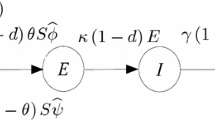Abstract
Interest has recently revived in the use of simple models for epidemic diseases. In particular, Anderson et al.1 have introduced an improved simple differential equation model for diseases such as fox rabies which regulate the population density of their host. Here I describe how such apparently simple models can be dissected into their basic components. This dissection facilitates a structural sensitivity analysis in which we explore the dependence of features of a model's behaviour on the assumptions regarding each component. I report that particular features can be related to particular components, for example, oscillations depend mainly on population growth and the generation gap of the disease, while estimates of the effect of potential control strategies such as vaccination or culling can be related directly to assumptions concerning the infection term and the way it changes with population density. Some features, for example, the level of prevalence of the disease and the period of any oscillations, turn out to be robust, depending mainly on basic ecological parameters. Others, including the crucial estimates regarding control, prove very sensitive to the details of the model. This is unfortunate, as the detailed form of the components is to a large extent chosen, not for ecological reasons, but to keep models simple, for example, the infectious period of a disease is often assumed to have an exponential distribution because this implies a constant death or recovery rate for infectious individuals which is mathematically very convenient for a continuous-time model. Because our dissection is in terms of components with straightforward ecological interpretations, any required improvements in modelling can be related to observational evidence which either exists or for which experiments can be suggested2,3.
Similar content being viewed by others
References
Anderson, R. M., Jackson, H. C., May, R. M. & Smith, A. M. Nature 289, 765–771 (1981).
Mollison, D. in Mathematical Aspects of Rabies Epizootics (ed. Bacon, P. J.) (Academic, London, in the press).
Bacon, P. J. & Macdonald, D. W. New Scient. 87, 640–645 (1980).
Bailey, N. T. J. The Mathematical Theory of Infectious Diseases 2nd edn (Macmillan, New York, 1975).
Dietz, K. in Epidemiology (eds Ludwig, D. & Cooke, K. L.) 104–121 (SIAM, Philadelphia, 1974).
Mollison, D. & Kuulasmaa, K. in Mathematical Aspects of Rabies Epizootics (ed. Bacon, P. J.) (Academic, London, in the press).
Bartlett, M. S. Stochastic Population Models (Methuen, London, 1960).
Stirzaker, D. R. J. Inst. Math. Applics 15, 135–160 (1975).
Author information
Authors and Affiliations
Rights and permissions
About this article
Cite this article
Mollison, D. Simplifying simple epidemic models. Nature 310, 224–225 (1984). https://doi.org/10.1038/310224a0
Received:
Accepted:
Issue Date:
DOI: https://doi.org/10.1038/310224a0
- Springer Nature Limited
This article is cited by
-
Planning for smallpox outbreaks
Nature (2003)
-
Allometry and simple epidemic models for microparasites
Nature (1996)





